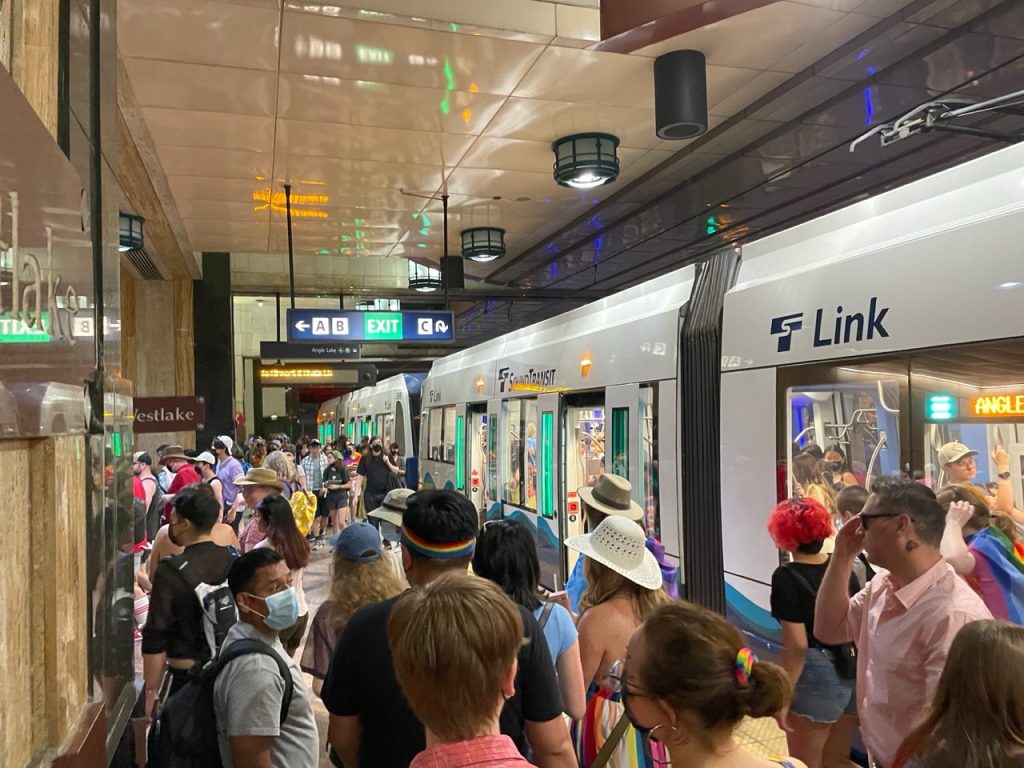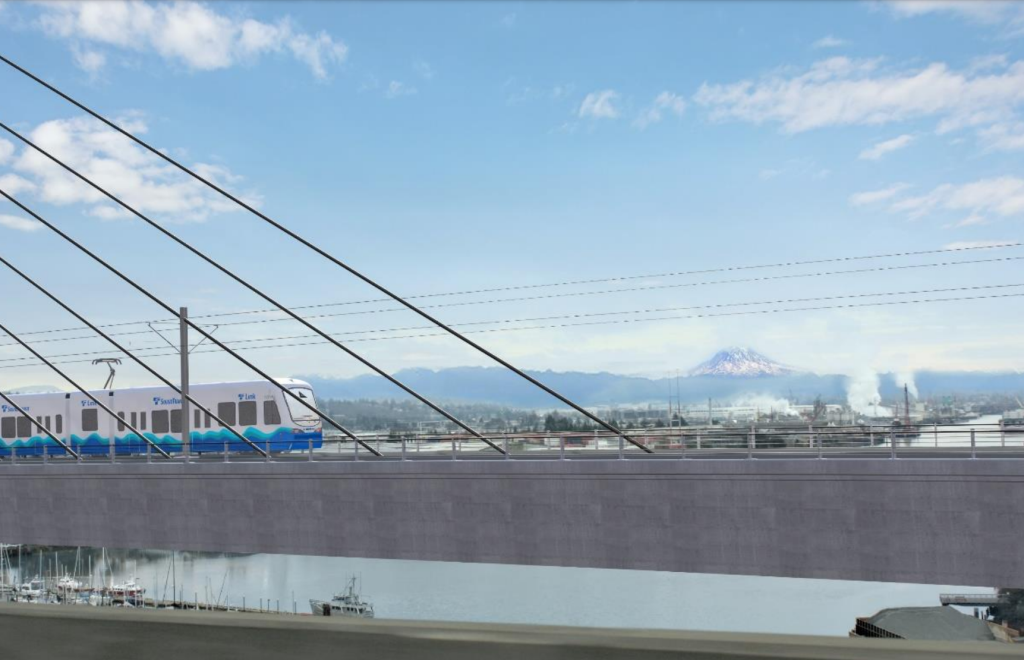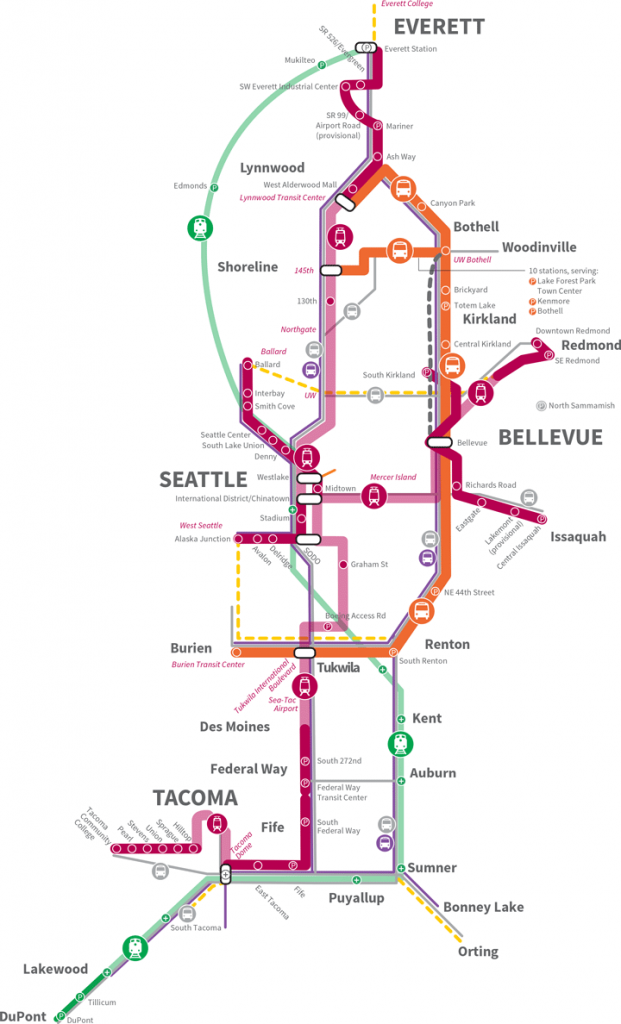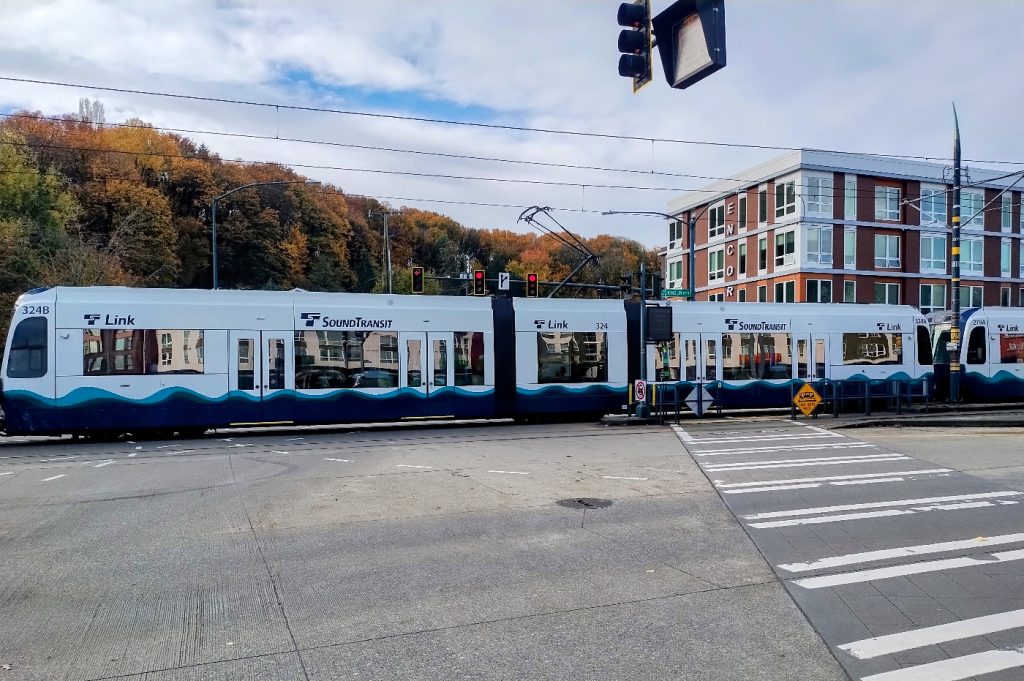
On March 27, the Sound Transit Board of Directors made it official after months of speculation: Dow Constantine is the regional transit agency’s new CEO. While the board picking one of its own came with plenty of controversy, the argument that a long-time insider would have a quicker learning curve and the deftness to handle the delicate regional politics won the day. But even with that leg up, Constantine faces a tall task as he grapples with huge challenges facing the agency.
The looming questions are manifold for an agency struggling with operational reliability, project delivery, and its reputation in the community. As the Dow era at Sound Transit gets underway, The Urbanist’s newsroom will be watching intently for signs of what’s next, whether progress or backsliding. Here are some of the top issues we’re tracking.
- Will operations really get a new focus?
- How will the agency handle an inevitable financial reset?
- Will a focus on “completing the spine” leave riders behind?
- Will attention on Rainier Valley fall by the wayside?
- Can the agency be transparent rather than insular?
How Constantine responds to these big issues will ultimately determine his success. Will he be remembered as a timely savior for a struggling agency that turned it around? Or an overconfident nepotism pick who failed to course correct at a key time, leaving wreckage in his wake?
Coming up short would surely damage a legacy that seemed all but assured when Constantine succeeding in getting the board to put the ambitious Sound Transit 3 measure on the ballot and pass it in 2016, queuing up 62 miles of light rail expansion and 46 miles of bus rapid transit. Getting voters to sign on to a bold vision, however, may prove to be a much easier task than actually delivering on that vision.
Will operations get a new focus?
For transit riders, the immediate headaches with Sound Transit begin with the increasing occurrence of service disruptions, both planned and unplanned. Many planned disruptions have been largely unavoidable growing pains as Sound Transit adds new lines or extensions. This includes the 10-day closure of the Downtown Seattle Transit Tunnel the agency has started today, truncating 1 Line service to prepare for 2 Line extension. However, the unplanned disruptions have started to point toward underlying issues with maintaining equipment and taking operations seriously, in general.
Case in point: a recent consultant report looking at system breakdowns found that Sound Transit’s train power and control systems are “more complex than necessary,” leaving the rail system vulnerable to catastrophic breakdowns. The report found these unexpected outages have really added up over the 11 months studied: 177 incidents of passenger trips interrupted by power, mechanical, or signal breakdowns added up to 432 hours of reduced service, roughly one out of every 14 hours the agency was scheduled to provide service over that period. And since these were unplanned outages, riders had no idea when to expect them, increasing frustrations and discouraging trips.
Those operational issues have been combined with foundational issues that Sound Transit riders have brought up for much of its existence: lack of wayfinding, the sporadic availability of real-time arrival information at stations, and of course — a propensity for the agency’s elevators and escalators to break down.

Board members new and old have acknowledged the need for Sound Transit to grapple with increased operational needs as it continues to open new service. The agency brought in megaproject expert Terri Mestas to overhaul the agency’s capital delivery program, in line with recommendations from the Sound Transit technical advisory group (TAG). A similar effort is needed for its operations program. Sound Transit is currently searching for a permanent deputy CEO for Service Delivery, and that hire will represent one of Constantine’s first major tests as a new CEO trying to turn his vision into reality.
Sound Transit has long had a reputation as an agency that doesn’t take rider experience as seriously as it takes service expansion. While there was some improvement under CEO Julie Timm and then interim CEO Goran Sparrman, it will quickly become apparently whether this issue is a real priority for its new CEO.
How will the agency handle an inevitable financial reset?
Costs are up and federal resources are deeply imperiled for the next four years under the Trump Administration, which is increasingly hostile to transit. It doesn’t take a genius to see that the agency’s financial plan and project schedule is likely headed to another reset — after an earlier pandemic-triggered reset in 2021.
In part due to planning delays, no light rail projects are set to apply for major federal grants in the next three years. Despite originally being tabbed to open in 2030, West Seattle Link and Tacoma Dome Link are now tabbed for 2032 and 2035, respectively. This gives Sound Transit some time to plan and hope for a friendlier administration taking over by 2029, which Sound Transit Systems Expansion Committee chair Claudia Balducci noted. Balducci is running for King County Executive and hoping to prevail in November to succeed Constantine.
“Federal funding has been a key part of our of our financial plan,” Balducci said. “Luckily, as you’ve probably heard, we weren’t expecting to go out for any big new grants in the next few years. So the timing could be worse. There’s definitely a little bit of latitude where we’ve got some time to figure some of this stuff out.”

On the flip side, most ST3 projects are getting fairly far along in planning, which makes it difficult to make major changes this late in the game. For example, a potential cost-cutting measure that Balducci and some other transit advocates floated involved reconnecting West Seattle and Ballard Link and building it as a driverless metro so that the trains (and thus stations) could be smaller, cutting down on station construction costs, and ongoing operating costs. However, the board (led by Constantine) rejected that idea, arguing they didn’t need a plan B for the agency’s split-spine concept.
“The way our project works, as the studies get further down the line, as the engineering expands, it becomes harder and harder to inject new ideas or reinject old ideas, because now you’ve got a lot of sunk costs,” Balducci said. “And you’re talking about really big dollars to go backwards. So I don’t know if it would be worth it to try to go backwards, but I feel like, when somebody says something like, ‘hey, what about this?’ We should consider it. We should consider it to show people why we’re not doing that.”

West Seattle Link represents a big test. Constantine has been a major supporter of the project as a West Seattle resident, but the project remains one of the most expensive elements of ST3 on a per-rider basis, particularly after the agency revealed ballooning costs on the magnitude of 75% last year. Moving forward on West Seattle could impact the agency’s ability to deliver the much more valuable Ballard Link, with its tunnel under Downtown Seattle that will benefit the entire region.
“We are in a strong position to deliver what voters approved,” Constantine told the West Seattle Rotary Club earlier this year, standing by the project. “The scope is really the question – such as, do you build the Avalon station or not? – there are 100 questions like that, that the board’s going to have to answer.”
Will a focus on “completing the spine” leave riders behind?
Both Constantine and his Deputy County Executive Shannon Braddock — who is now acting Executive and a member of the agency’s board — have stressed completing the light rail spine to Tacoma and Everett in their public remarks. This is sound politics, if not sound transit planning, and it’s likely pledges like these that helped Constantine win the support of a majority of board members in order to land his new gig.

“Completing the spine” means different things to different people, however. Board members from Snohomish County, for example, seem to view a low-productivity detour over to Paine Field — a move that could ultimately delay light rail’s arrival in Downtown Everett — as the same thing as completing the spine. A more direct route along SR 99 or I-5 could save more than a billion dollars in construction cost and speed up travel times to nearly all destinations, but has already been officially ruled out by the board. This illustrates how “the spine” is essentially just a shorthand for providing Pierce County and Snohomish County everything that was promised in ST3, and an incredible amount of skepticism comes with anything that might stand in the way of that.
But completing the spine has also been used as an excuse to sidestep valuable projects that would benefit riders on the entire system, including the pivotal Jackson Street transit hub as part of Ballard Link. Both Everett Mayor Cassie Franklin and Snohomish County Executive Dave Somers voted against studying a potential station along 4th Avenue in 2023, pointing to extra costs that could impact the spine.
Will the new CEO advocate for projects that deliver stellar transit, or will he side with board members who are more concerned with getting their share of the pie?
Will attention on Rainier Valley fall by the wayside?
Constantine, in his role as King County Executive, appointed King County Councilmember Girmay Zahilay to the Sound Transit Board in early 2024. Having a Rainier Valley representative on the board has shined a spotlight on the issues with traffic safety on the 1 Line’s at-grade segments along MLK Way S and in SoDo. Nonetheless, it’s not clear if dramatic interventions are really on the table, and many fixes would require buy-in from the City of Seattle.

The foolproof option to prevent train collisions on MLK Way would be to elevate tracks through this section, like they’ve been elevated throughout much of the network. Another solution floated by The Urbanist‘s Stephen Fesler would be to dig a light rail tunnel under Rainier Avenue and convert the MLK Way line into a streetcar. Costs would be high for any grade-seperation fix and funding has yet to be identified.
In fact, funding has yet to be identified even for more incremental fixes like redesigning intersections along MLK Way, limiting car movement and adding traffic barriers to prevent illegal turns. While much rides of the agency’s partnership with Seattle, the next CEO will likely need to be out front using the bully pulpit to keep momentum on Rainier Valley safety improvements. Last year, when Constantine was likely already eyeing the CEO seat, he voiced support for building a longer-term vision for light rail through South Seattle.
“Between now and finalization of the master plan next spring, I’d like to see the agency begin planning for long-term options for the community and the board to consider,” Constantine said at the time. “One first step would be to look at the operational system needs to meet future ridership headways and service profiles, including looking at additional north-south alignments. I would like this planning effort to look at operational solutions as well as capital options. It should also include information related to service reliability and the potential need for additional light rail vehicles.”
A focus on improving MLK has come and gone before, and we’ll be watching to see whether the issue remains on the agency’s radar as more immediate issues threaten to eclipse it.
Can the agency be transparent rather than insular?
One complaint that stakeholders, journalists, and boardmembers have shared is Sound Transit’s tendency to shroud key decisions in secrecy and not show their work as their reach key decisions.
The CEO selection process continued that unfortunate trend. Good reasons exist to allow top executive applicants to remain anonymous, particularly providing a incentive for top talent to apply without risking their current position. However, other parts of the selection process were shrouded with little good reason. And plenty of agency decisions that don’t face such obstacles also remain opaque, with agency spokespeople often seeking to obfuscate and deflect rather than provide forthright answers that illuminate what’s animating the agency.
Balducci acknowledged the problem, while also pledging redoubled efforts to do better.
“I said this a few times today, and I mean it: we need to be more transparent with showing the public what we know about the problems facing the agency so that we can start having public conversations about the solutions,” Balducci said on March 27. “It’s just going to have to happen.”
Last year, Sound Transit staff clearly and openly shared the tradeoffs that could come from adding new station alternatives for Ballard Link, with the goal of avoiding construction impacts in South Lake Union. Communicating the downsides helped the board stand up to some powerful interests and reject adding new SLU options that would have delayed the project. Widely praised at the time as a big improvement in board communication, the episode represents exactly the direction that the agency needs to be moving in.
But especially as pressure increases and the agency comes up against major deadlines, backsliding will be a risk.
It will ultimately be up to Constantine — a man installed through a process that drew comparisons to cloistered Papal Conclave elections — to enact that shift toward transparency. Stranger things have happened.
If issues are addressed, Sound Transit’s potential remains sky high thanks to the ambitious expansions it has queued up and the incredibly high support for rapid transit in the region. If they build it — and build it well — the riders will come. A new focus on service reliability and rider experience will retain those riders over the long haul. The ingredients are there to turn greater Seattle into a world class transit region.



